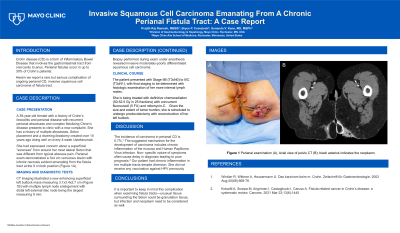Tuesday Poster Session
Category: IBD
P4425 - Invasive Squamous Cell Carcinoma Emanating From a Chronic Perianal Fistula Tract: A Case Report
Tuesday, October 29, 2024
10:30 AM - 4:00 PM ET
Location: Exhibit Hall E

Has Audio
- PR
Prajith Raj Ramesh, MBBS
Mayo Clinic
Rochester, MN
Presenting Author(s)
Prajith Raj Ramesh, MBBS, Bryce Comstock, BSc, Sunanda V. Kane, MD, MSPH
Mayo Clinic, Rochester, MN
Introduction: Crohn disease (CD) is a form of Inflammatory Bowel Disease that involves the gastrointestinal tract from oral cavity to anus. Perianal fistulas occur in up to 30% of patients. Herein we report a rare but serious complication of ongoing perianal CD, invasive squamous cell carcinoma of fistula tract.
Case Description/Methods: A 39-year-old female with a history of Crohn’s ileocolitis and perianal disease with recurrent perianal abscesses and complex fistulizing Chron’s disease presents to clinic with a new complaint. She has a history of multiple abscesses, Seton placement and a diverting ileostomy created over 10 years ago doing well on every 4-week Ustekinumab. She had expressed concern about a superficial “soreness” from around her most lateral Seton that was different from typical abscess pain. Perianal exam demonstrated a 3x4 cm verrucous lesion with inferior necrosis evident emanating from the fistula tract at the 9 o’clock position (Figure 1A). CT imaging illustrated a new enhancing superficial left buttock mass measuring 3.1x3.4x2.7 cm (Figure 1B) with multiple lymph node enlargement with distal left external iliac node being the largest measuring 9 mm. Biopsy performed during exam under anesthesia revealed invasive moderately-poorly differentiated squamous cell carcinoma.
Given the suspicion for metastasis, a total proctocolectomy with radical buttock resection with muscle flap reconstruction along with chemotherapy after radiation has been planned.
Discussion: The incidence of carcinoma in perianal CD is 0.7%.1 The suggested mechanism for the development of carcinoma includes chronic inflammation of the mucosa and Human Papilloma Virus infection. Non- specific nature of symptoms often cause delay in diagnosis leading to poor prognosis.2 Our patient had chronic inflammation in her multiple tracts despite diversion. She did not receive any vaccination against HPV previously. It is important to keep in mind this complication when examining fistula tracts—unusual tissue surrounding the Seton could be granulation tissue, but infection and neoplasm need to be considered as well.
Reference
1. Winkler R, Wittmer A, Heusermann U. Das karzinom beim m. Crohn. Zeitschrift für Gastroenterologie. 2002 Aug;40(08):569-76.
2. Kotsafti A, Scarpa M, Angriman I, Castagliuolo I, Caruso A. Fistula-related cancer in Crohn’s disease: a systematic review. Cancers. 2021 Mar 22;13(6):1445.

Disclosures:
Prajith Raj Ramesh, MBBS, Bryce Comstock, BSc, Sunanda V. Kane, MD, MSPH. P4425 - Invasive Squamous Cell Carcinoma Emanating From a Chronic Perianal Fistula Tract: A Case Report, ACG 2024 Annual Scientific Meeting Abstracts. Philadelphia, PA: American College of Gastroenterology.
Mayo Clinic, Rochester, MN
Introduction: Crohn disease (CD) is a form of Inflammatory Bowel Disease that involves the gastrointestinal tract from oral cavity to anus. Perianal fistulas occur in up to 30% of patients. Herein we report a rare but serious complication of ongoing perianal CD, invasive squamous cell carcinoma of fistula tract.
Case Description/Methods: A 39-year-old female with a history of Crohn’s ileocolitis and perianal disease with recurrent perianal abscesses and complex fistulizing Chron’s disease presents to clinic with a new complaint. She has a history of multiple abscesses, Seton placement and a diverting ileostomy created over 10 years ago doing well on every 4-week Ustekinumab. She had expressed concern about a superficial “soreness” from around her most lateral Seton that was different from typical abscess pain. Perianal exam demonstrated a 3x4 cm verrucous lesion with inferior necrosis evident emanating from the fistula tract at the 9 o’clock position (Figure 1A). CT imaging illustrated a new enhancing superficial left buttock mass measuring 3.1x3.4x2.7 cm (Figure 1B) with multiple lymph node enlargement with distal left external iliac node being the largest measuring 9 mm. Biopsy performed during exam under anesthesia revealed invasive moderately-poorly differentiated squamous cell carcinoma.
Given the suspicion for metastasis, a total proctocolectomy with radical buttock resection with muscle flap reconstruction along with chemotherapy after radiation has been planned.
Discussion: The incidence of carcinoma in perianal CD is 0.7%.1 The suggested mechanism for the development of carcinoma includes chronic inflammation of the mucosa and Human Papilloma Virus infection. Non- specific nature of symptoms often cause delay in diagnosis leading to poor prognosis.2 Our patient had chronic inflammation in her multiple tracts despite diversion. She did not receive any vaccination against HPV previously. It is important to keep in mind this complication when examining fistula tracts—unusual tissue surrounding the Seton could be granulation tissue, but infection and neoplasm need to be considered as well.
Reference
1. Winkler R, Wittmer A, Heusermann U. Das karzinom beim m. Crohn. Zeitschrift für Gastroenterologie. 2002 Aug;40(08):569-76.
2. Kotsafti A, Scarpa M, Angriman I, Castagliuolo I, Caruso A. Fistula-related cancer in Crohn’s disease: a systematic review. Cancers. 2021 Mar 22;13(6):1445.

Figure: Figure 1: Perianal examination (A), Axial view of pelvis CT (B); black asterisk indicates the neoplasm.
Disclosures:
Prajith Raj Ramesh indicated no relevant financial relationships.
Bryce Comstock indicated no relevant financial relationships.
Sunanda Kane: Janssen – Advisory Committee/Board Member.
Prajith Raj Ramesh, MBBS, Bryce Comstock, BSc, Sunanda V. Kane, MD, MSPH. P4425 - Invasive Squamous Cell Carcinoma Emanating From a Chronic Perianal Fistula Tract: A Case Report, ACG 2024 Annual Scientific Meeting Abstracts. Philadelphia, PA: American College of Gastroenterology.
